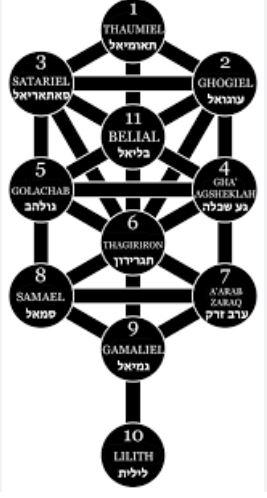
The Qliphoth (from the Hebrew: "shells" or "coverings") are the dark, distorted side of the Kabbalistic Tree of Life. While the classical Tree of Life (the Sefirot) represents divine order, light, and spiritual harmony, the Qliphoth represent chaos, shadows, the unconscious, and the abysmal. They are, in a sense, the reverse side of spiritual development—the part many seek to avoid, but one must pass through if one truly wants to know oneself.
The Qliphoth are not "evil demons" in the classical sense. They symbolize distorted forms of divine principles—such as lust, power, knowledge, or emotion—that are out of balance. These forces are destructive when repressed or expressed uncontrollably, but they can have a transformative effect when consciously confronted. In modern magic and spirituality (especially on the left-hand path), the Qliphoth are considered the key to self-knowledge and inner power—through confronting the shadow.
In the classical Kabbalistic structure, there are ten Qliphoth, each of which is the dark reflection of a sefirah. They are each assigned to a demonic principle or an archaic spirit, such as Lilith, Samael, Asmodeus, or Belphegor. These beings embody fundamental shadow aspects of the human psyche: sexual desire, delusion, destructive rage, narcissistic illusion, false light, spiritual pride, and so on. The lowest point of the system—Thaumiel—symbolizes the rebellion against God Himself, the absolute ego, the anti-unity.
Spiritual work with the Qliphoth is not a game. It is deep, confronting, uncomfortable—but also powerful. It is about recognizing repressed aspects of the self, not condemning them, but penetrating them. Many modern magicians, especially in the Draconian or Luciferian systems, use the Qliphoth as "dark initiatory stages." Each passage through a Qlipha is like a spiritual trial: You encounter an aspect of yourself that frightens or hurts – and emerge transformed.
There are various paths to this: You can approach the Qliphoth through meditation, dream work, ritual magic, or shamanic techniques. It's important to note that this work requires discipline, psychological stability, and a deep inner willingness to change. Those who enter it carelessly or out of selfish motives risk losing themselves.
The Qliphoth are not a place of darkness for darkness's sake – they are gateways to transformation. Those who approach them with respect, alertness, and courage can not only integrate their shadows but also recognize the light behind them.

